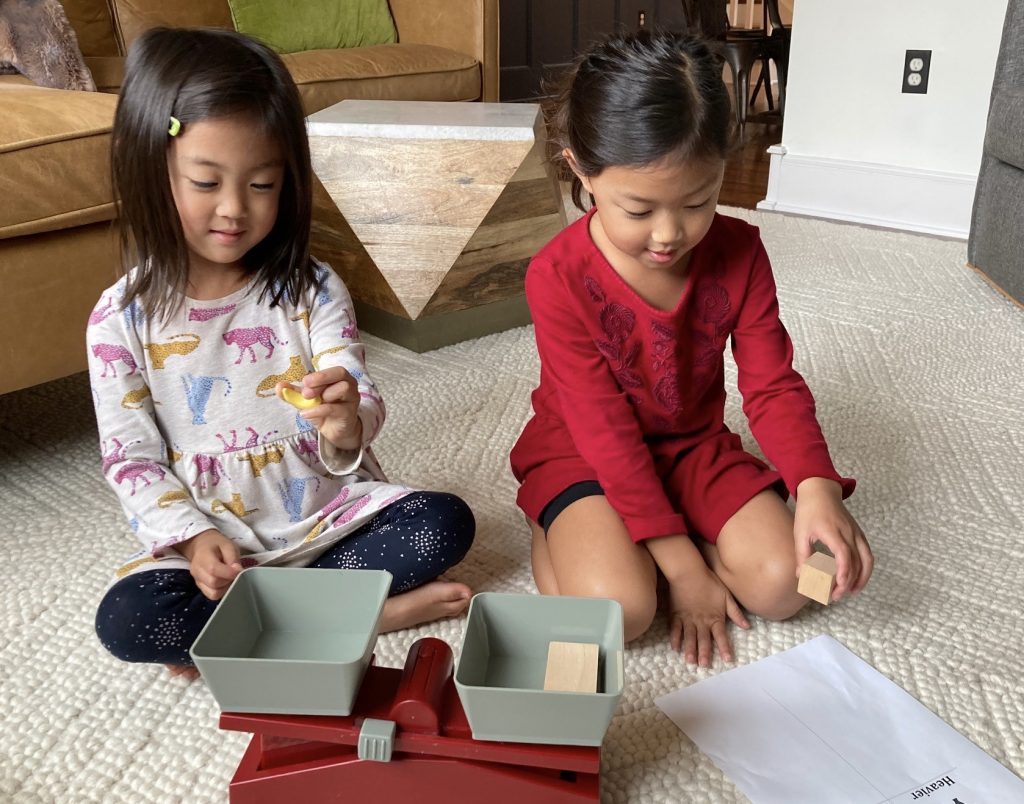Materials
- Balance
- Base object
- Collection of objects (choose objects that are small enough to fit in the balance cups; use materials that children are not used to seeing to increase engagement)
- Sorting Guide and/ or recording page
Setup — Less than 5 minutes
- Gather at least 5 objects that vary in weight and fit in the balance. Include one base object. You can put a sticker on the base object to identify it if needed.
- Provide some type of sorting guide with a “heavier” section and a “lighter” section. This could be made from a sectioned container, a “T” chart made of tape on a table, or use the provided sorting guide.
Instructions
1. Children are given a balance and a “base object” of medium weight relative to the other objects that is placed on one side of the balance. Children also receive a Sorting Guide and a collection of objects to weigh.
2. Children compare each object from the collection to the base object one at a time. If an object is heavier than the base object, they put it in a “heavier” pile. If an object is lighter than the base object, they put it in a “lighter” pile.
3. Optionally, have children record which objects go in each pile on a Recording Page
4. The activity ends when all the provided objects have been weighed and sorted into piles.

Checks for Understanding
To deepen children’s learning about early math concepts, talk and ask questions while doing this activity together. Here are some examples to get you started.
“Which object feels heavier?”
Use an object that is a very different weight than the base object: “What happens when you put this object on the other side of the balance?”
“When you look at the balance, how do you know which object is heavier?”
- “You figured out that the banana is lighter than the toy tiger, so where does the banana go? What other things were lighter than the toy tiger?”
- “What are some things that are the same about all the objects in this pile?”
- “Is your object heavier or lighter than the base object?”
- “I see that both the penny and the block are lighter than the toy elephant. Which one is the lightest? What does it mean if something is the lightest?”
- “Which one do you think will be heavier? How did you know that?” After weighing the two objects: “Which one is heavier? Did you guess correctly?”
Activity Modifications
Once you have tried out the activity, here are some other things you can do. Try these modifications to keep the activity interesting and challenging for students all year.
Have heavier objects be bigger and lighter objects be smaller if children do not understand the concepts of heavier or lighter yet.
- Introduce non-standard units by weighing a base object, then weighing a lighter object, then adding more units of the lighter object to see how many it takes to outweigh the base object.
For example, weigh a dry erase marker on one side and then add Unifix cubes to the other side to determine how many Unifix cubes it would take to outweigh the dry erase marker. - Increase engagement by having students collect their own objects to weigh.
- If you don’t have a balance or you want to add a variation to the activity, have students compare weights of objects by hand. Make sure the objects have very different weights to make comparison easier.
- Count how many objects are heavier and lighter than the base object. Keep an ongoing count or tally for different base objects.
- After weighing all objects, have students order the objects from lightest to heaviest.